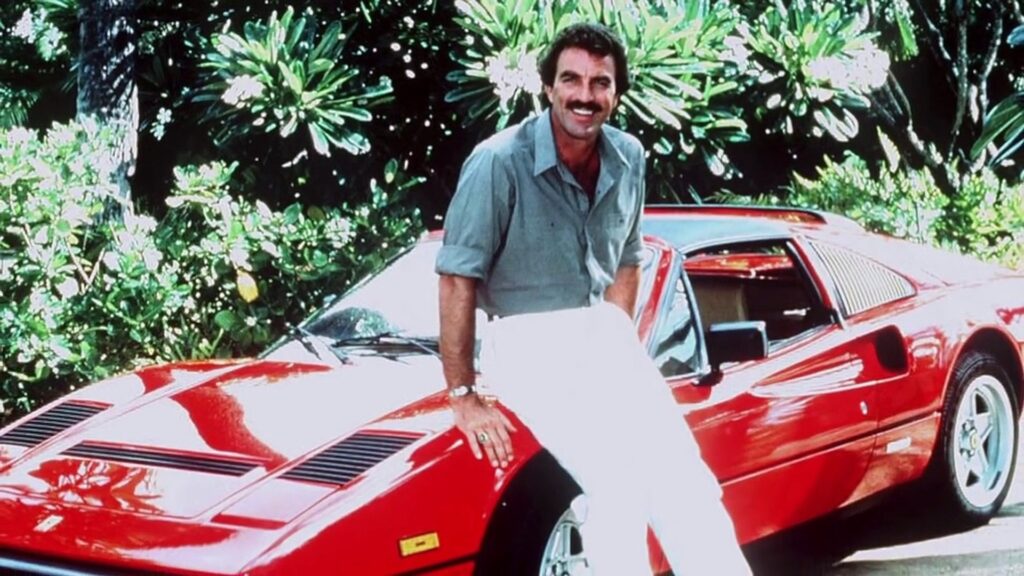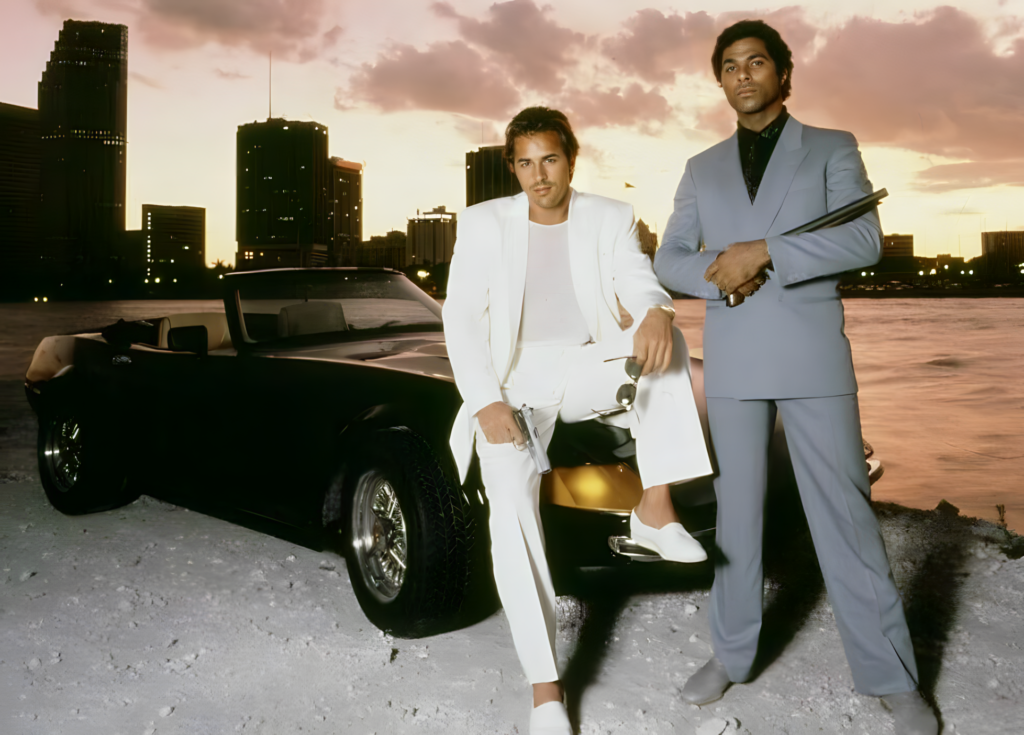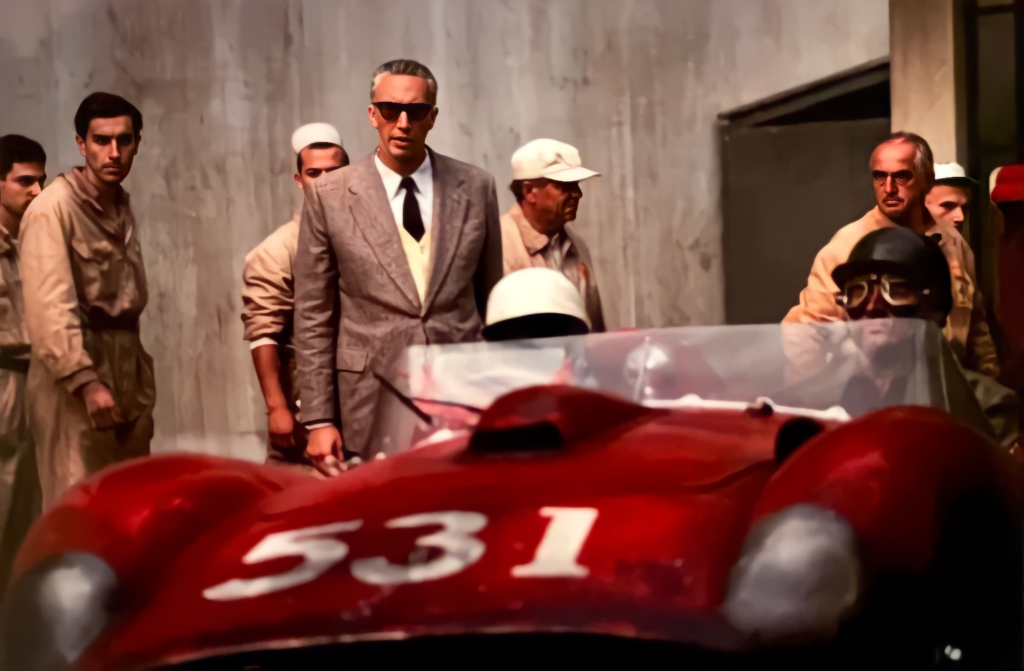From the debut of “Magnum PI” in 1980, Hollywood began an unrequited love affair with the Ferrari, objectifying, worshipping it and turning it into a glorified sex symbol much as it did Marilyn Monroe.
By TONY CASTRO
I AM FLYING OVER THE TOP OF Los Angeles in the world’s greatest sports car, clocking speeds well above 100 miles an hour then quickly braking to a fraction of that to keep the Ferrari from sailing off a winding curve on Mulholland Drive and into a canyon below — and it’s like orgasming in a dream. I am either about to wake up or go the way of James Dean, hypnotized as I am by the Ferrari’s spine-tingling engine sound as enchanting as the seductive sirens of Greek mythology.
VRRRAHVRROOORAAAEEEAAAEEEEHHH!
The Ferrari attacks the hairpin sounding ruthlessly louder and higher pitched than any other car, the whine of the turbocharger soaring skyward as revs build up.
VRRRAHVRROOORAAAEEEAAAEEEEHHH!
And this was not just any Ferrari but O.J. Simpson’s 1985 red Ferrari Testarossa, back when America adored and cheered for O.J., and no one even knew he owned a Bronco. I’m out of my mind soaking it up and knowing that at any moment I’m going to paste myself on the side of the hill or I’ll be nabbed, hassled and cuffed by cops suspecting I’ve boosted the Juice’s Ferrari — the license plate reads “JUICES,” which I’m obviously not — like they did to an innocent Marcus Allen when he took it joy riding the year he won the Heisman.
VRRRAHVRROOORAAAEEEAAAEEEEHHH!
Were there wild beasts mating in there?
VRRRAHVRROOORAAAEEEAAAEEEEHHH!
VRRRAHVRROOORAAAEEEAAAEEEEHHH! It’s the whine of their turbocharger. There is nothing like the high-revving nature of Ferrari engines —VRRRAHVRROOORAAAEEEAAAEEEEHHH! — which typically have a redline of around 8,000 to 9,000 RPM, resulting in a high-pitched, high-energy sound that is distinct from other types of engines. Plus their dry-sump lubrication system allows for a lower placement of the engine in the car, producing a more aggressive exhaust note.
VRRRAHVRROOORAAAEEEAAAEEEEHHH!
And they use specific exhaust systems and mufflers designed to enhance the engine’s sound.
Marcus had told me about this during our interviews. I was profiling him for Sports Illustrated magazine in his banner year with the transplanted Los Angeles Raiders when he mentioned the arrest no one had known about and how O.J. had loaned him the car, not realizing that there was an unresolved mix-up with the registration. So I asked O.J. about it. What does he do? He tries to sell me the Testarossa. Take it for a spin, he said, and buy it from me. I did. Took it for a spin.
VRRRAHVRROOORAAAEEEAAAEEEEHHH!
Up Coldwater Canyon, Mulholland all the way until I overlooked the 405, then easterly back to the Jerome C. Daniel Overlook above the Hollywood Bowl. Chicago was performing that night.
VRRRAHVRROOORAAAEEEAAAEEEEHHH!
Buying it? This $120,000-plus marvel of Italian engineering, with my insurance record of having had one Porsche stolen and blowing up another in the middle of Harvard Square? But that’s another story.

This was the age of the Ferrari in Hollywood. O.J. Clint Eastwood. Gene Hackman. Michael J Fox. From Tom Selleck to Christie Brinkley, the Red Ferrari 308 GTS became the ride of Eighties Hollywood Gods, as one magazine labeled it. From the debut of “Magnum PI” in 1980, Hollywood began an unrequited love affair with the Ferrari, objectifying, worshipping it and turning it into a sex symbol much as it did Marilyn Monroe.
What was it Tim Allen once said about chicks and Ferraris? “Women are like cars. We all want a Ferrari.”
The blonde saleswoman at Hollywood Sports Cars who taught me everything I knew about Ferraris says women feel much the same way: “There’s not a woman I know who secretly doesn’t want to sit on the Ferrari gearshift.” But that’s another story too.
That Ferrari that became the car Magnum borrowed off Robin Masters and followed the world-famous PI through eight seasons, 162 episodes and two Golden Globes to become one of the most famous cars of its era was almost as synonymous with the show as the young hunkish Tom. And soon it had company.
In 1984, NBC jumpstarted what quickly stole the thunder as the hottest show on television, the crime drama “Miami Vice” featuring a black Ferrari 365 GTS/4 Daytona Spyder Daytona, the wheels of Detective Sonny Crockett portrayed by actor Don Johnson. The Ferrari was such a hit that it created a market for a hot selling battery-operated kids toy the next Christmas. The Cabbage Patch Doll of Hollywood, some called it.
For hardcore “Miami Vice” fans and car buffs, it didn’t matter that Crockett’s Ferrari was not an authentic Daytona Spyder. Sonny’s Ferrari was a replica built on a Corvette C3 chassis by Tom McBurnie of McBurnie Coachcraft, who produced two samples: one for the glamor shots and the other to take a good beating during stunts.

“Miami Vice” had to use a replica because it was cheaper — and because Ferrari North America refused to supply authentic Ferraris to the show, a decision it would soon regret. But the show became such a big hit and the Daytona Spyder replica so famous that Ferrari North America came unglued. Ferrari sued McBurnie Coachcraft, and also had a change of heart. It supplied “Miami Vice” with a real Testarossa for Season Three.
By then producer Michael Mann had assumed full control of “Miami Vice” and loved upgrading the black Daytona with a white Testarossa. Mann had chafed at using a replica. He had long been in love with Ferraris, and the idea of doing a film about founder Enzo Ferrari had been in his system for almost two decades.
“I was in film school in London,” says Mann, recalling it was 1967 when he first laid eyes on a Ferrari. “I wasn’t that interested in cars. But this Ferrari was different. This was like, I don’t know, a piece of sculpture that suddenly is moving like some beast, savage and beautiful and exquisite.”
And this was long before Mann became one of the new geniuses of Hollywood, wanting to direct motion pictures but willing to sidestep into television. This is a man who, like many in the make-believe industry, went from having nothing to owning a Ferrari almost overnight. He didn’t know how to write. He didn’t know story development. But he had an ear for authentic dialogue, and he had good friends who unselfishly taught him to write and the elements of Hollywood story-making. Most importantly, Mann knew how to sell himself and his ideas.
In many ways, he was a lot like Enzo Ferrari, whose story of saving his family from financial ruin and turning a sports car with his name on it into what it is today. Mann, now 80, just needed to get to a point in his career where he could make this movie.
All his other films to date — most notably “Thief,” “Heat,” “The Insider,” “The Last of the Mohicans,” “Miami Vice,” “Ali” — perhaps were a buildup to his new film set in 1957 in Modena, Italy, with Formula One racing in the background and not a Ferrari replica in sight. It stars Adam Driver and Penelope Cruz, and “Ferrari” may just be the best film that Michael Mann has ever made.

The film takes place during the summer of 1957 when the forces of Enzo Ferrari’s life collide. His racecar company built by him and his wife Laura, is going broke. Their marriage has been overwhelmed by the death of their son, Dino, and by the existence of Enzo’s other son, 12-year-old Piero, the product of a wartime romance.
Ferrari gambles all their futures on one race — the dangerous and infamous 1957 Mille Miglia, racing 1,000 miles across Italy. It is during this race that Laura discovers Enzo’s secrets, and when life tests family and fortunes.
Mann came to know the Ferrari family personally and Enzo well enough to get into his head. As he recalled:
“And at some point, [Enzo] thought, Modena’s filled with these wonderful craftsmen. Why don’t I throw a good leather interior into this and get a great paint job on it? Maybe somebody’s foolish enough to buy this. Because you’re buying a car that maybe only runs between 5,000 and 8,000 rpms. You have to keep it going by throttle control and shifting gears. It’s meant to be driven hard. That’s why suburbanites who may have bought Ferraris in the ’60s started complaining, ‘Well, they don’t run. They break down.’”
But in the age of the Ferrari and Hollywood in the 1980s, Michael Mann was just another player, albeit one who was getting rich, but still not rich enough to do the Enzo Ferrari story the way he wanted it done.
He was then also trying to turn “Miami Vice “into the cornerstone of a television empire. But even with a hit series, it was as if “Miami Vice” wasn’t getting the respect given to CBS’s longer-running “Magnum PI.” And Tom Selleck’s Ferrari, a 308 GTS Quattrovalvole, was the real thing, not a replica.
Mann may not have been aware that if Selleck had gotten his automotive wish from the start, the show wouldn’t even have used the Ferrari 308GTSi — that has become known as the Magnum Ferrari. Selleck had initially requested that his PI character should drive a Porsche 928, a car Selleck liked so much that he had bought them as presents for his buddies.
One of the stories floating in Hollywood at that time was that Mann had turned down a gorgeous red Ferrari for Sonny Crockett to drive because he thought it would look too much like a rip off of the red Ferrari that Selleck had been driving in “Magnum P.I.” You have to know Michael Mann. Nothing would give him a heart attack quicker than being labeled derivative, especially when it came to “Magnum PI.”
Plus, Mann was getting bored, and “Miami Vice” had become as boring as the plain vanilla Testarossa of Season Three. As beautiful as it was, that real Ferrari was a blow to hard-core “Miami Vice” fans who loved the black Daytona.
“I was very proud of the first two years of the show,” Mann now says. “After two years, I wasn’t made for running one of these. I could have made gazillions of dollars. But I wanted to do “Manhunter” and moved on, and the stories nose-dived after that.”
Mann also had a new NBC cops drama, “Crime Story,” that was having more than its share of problems shooting on location in Chicago. An elevator crash that first season had NBC executives worried about the costs and about Mann dividing time between Miami and Chicago, not to mention that his attention was also on the about to be released “Manhunter,” the 1986 thriller based on the 1981 novel “Red Dragon” by Thomas Harris.

And in all transparency, let me acknowledge that I was a writer for Mann on the “Crime Story” series writing team and that I am a longtime friend of Tom Harris, with whom I started my newspaper reporting career in Texas — even covering cops with him. That, too, is another story.
By then, the Ferrari was becoming a staple in some major Hollywood motion pictures, most notably in John Hughes’s 1986 “Ferris Bueller’s Day Off.” You know the story. The mischievous Ferris plays hooky and ropes in his girlfriend Sloane and best friend Cameron to join him in a short road trip to nearby Chicago in Cameron’s father’s prized 1961 Ferrari 250 GT California Spyder.
Say a prayer for the Ferrari. In Chicago, a parking lot valet takes the Ferrari for a joyride, the “Star Wars” theme playing in the background, as the Ferrari goes airborne. When Ferris and friends return home, the Ferrari accidentally skids off a jack, crashes through a window, and plummets to its death.
The car enthusiasts who were inconsolable by that scene can stop worrying. All three Ferraris used in the making of “Ferris Bueller’s Day Off” were replicas, and the fake Ferrari that flew out the window didn’t even run.
Perhaps in a business so reliant on stunt people, the use of replica Ferraris shouldn’t be too surprising.
And the Ferrari was fully capable of holding its own. Take one of the best car chase scenes in the history of film, director Taylor Hackford’s 1984 “Against All Odds” with a street race between a red Porsche 911 SC Cabriolet (driven by Jeff Bridges’ aging football player) and a black Ferrari 308 (driven by James Woods’ nightclub owner character) weaving in and out of dense traffic and through intersections on Sunset Boulevard through Bel Air.
Then there was the 1992 sentimental favorite “Scent of a Woman” in which a 1989 Ferrari Mondial T Cabriolet is featured in a six-minute scene being driven by the blind maniacal retired Army Lieutenant Colonel Frank Slade, the character played by Al Pacino. The colonel makes turns in a fairly deserted Brooklyn neighborhood without so much as scratching the car before scaring the hell out of Chris O’Donnell, the scholarship prep school student hired to take care of the colonel during a Thanksgiving weekend, by suddenly speeding up the Ferrari dangerously.
“You’ll get us killed,” pleads Chris O’Donnell’s character.
“Don’t blame me, Charlie,” says Pacino’s colonel. “I can’t see.”
That is about how I felt in my joy ride in O.J.s Testarossa. I had to admit what I had long denied. We baby boomers were a reckless generation. Maybe we hadn’t thought about it that way. But as Alice Cooper so aptly once observed: “The hippies wanted peace and love. We wanted Ferraris, blondes and switchblades.”
And it’s difficult to drive another car after driving a Ferrari.
I’ve never gotten such a rush except maybe the time I did an open mic standup routine my first year in L.A. at the Comedy Store on the Sunset Strip, glamorously made up as Marilyn Monroe and looking like a million dollars: wearing a slinky silver chainmail mini dress with a halter neckline, low cut draped back, and side slits with hi-low hem that screamed, “Knock me down and fuck me!”
Which may account for the pinch I felt on my butt. Seriously? I turned around to discover that, damn, I had just been goosed by Joan Rivers who had been standing behind me. Not only had she goosed me but so hard that I suspected she had ripped my sexy lace panties. Seriously.
“Your gorgeous rhinestone strap stiletto sandals,” Joan said, taking me in from my platinum blonde wig down to the stilettos. “Are those Manolo Blahniks?”
And that, for sure, is another story.
Tony Castro, the former award-winning Los Angeles columnist and author, is a writer-at-large with the LAMonthly. He can be reached at tony@tonycastro.com.





